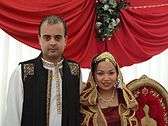Wedding
A wedding is a ceremony where two people are united in marriage. Wedding traditions and customs vary greatly between cultures, ethnic groups, religions, countries, and social classes. Most wedding ceremonies involve an exchange of marriage vows by the couple, presentation of a gift (offering, ring(s), symbolic item, flowers, money), and a public proclamation of marriage by an authority figure. Special wedding garments are often worn, and the ceremony is sometimes followed by a wedding reception. Music, poetry, prayers or readings from religious texts or literature are also commonly incorporated into the ceremony.
Common elements across cultures
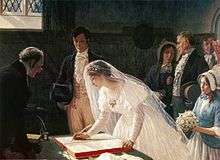
Some cultures have adopted the traditional Western custom of the white wedding, in which a bride wears a white wedding dress and veil. This tradition was popularized through the marriage of Queen Victoria. Some say Victoria's choice of a white gown may have simply been a sign of extravagance, but may have also been influenced by the values she held which emphasized sexual purity.[1] Within the modern 'white wedding' tradition, a white dress and veil are unusual choices for a woman's second or subsequent wedding.
The use of a wedding ring has long been part of religious weddings in Europe and America, but the origin of the tradition is unclear. One possibility is the Roman belief in the Vena Amoris, which was believed to be a blood vessel that ran from the fourth finger (ring finger) directly to the heart, Thus when a couple wore rings on this finger, their hearts were connected. Historian Vicki Howard points out that the belief in the "ancient" quality of the practice is most likely a modern invention.[2] "Double ring" ceremonies are also a modern practice, a groom's wedding band not appearing in the United States until the early 20th century.[3]
The wedding ceremony is often followed by wedding reception or a wedding breakfast, in which the rituals may include speeches from the groom, best man, father of the bride and possibly the bride,[4] the newlyweds' first dance as a couple, and the cutting of an elegant wedding cake.
Traditional wedding clothing attire
- Cheongsam or Hanfu, Chinese traditional formal wear
- Batik and Kebaya, a garment worn by the Javanese people of Indonesia and also by the Malay people of Malaysia
- Hanbok, the traditional garment of Korea
- Barong Tagalog, an embroidered, formal men's garment of the Philippines
- Kimono, the traditional garments of Japan
- Sari/Lehenga, Indian popular and traditional dress in India
- Dhoti, male garment in South India
- Dashiki, the traditional West African wedding attire
- Ao dai, traditional garments of Vietnam
- Ribbon shirt, often worn by American Indian men on auspicious occasions, such as weddings, another common custom is to wrap bride and groom in a blanket
- Kilt, male garment particular to Scottish culture[5][6][7]
- Kittel, a white robe worn by the groom at an Orthodox Jewish wedding. The kittel is worn only under the Chupah, and is removed before the reception.
- Topor, a type of conical headgear traditionally worn by grooms as part of the Bengali Hindu wedding ceremony
- Western code
- Morning dress, western daytime formal dress
- Stroller
- White tie ("evening dress" in the UK; very formal evening attire)
- Evening Suits
- Black tie ("dinner jacket" in the UK; often referred to as a "tuxedo" in the US; traditionally appropriate only for use after 6:00 p.m. (not for weddings), but also seen in daytime, especially in the United States. It is considered inappropriate in Britain)
- Non-traditional "tuxedo" variants (colored jackets/ties, "wedding suits")
- Lounge suit
- Sherwani, a long coat-like garment worn in South Asia
- Wedding crown, worn by Syrian and Greek couples (which are called "τα στέφανα," which literally means "wreaths") and Scandinavian brides
- Wedding veil
- Wedding dress
- Langa oni, traditional two piece garment worn by unmarried Telugu Hindu women.
- Different wedding clothing around the world
-
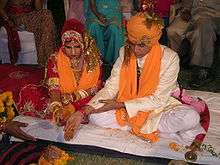
A bride and a bridegroom in Rajasthan
-
A bride and a bridegroom in Nepal
-

Neopagan handfasting ceremony
-
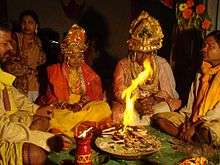
Fire rituals at a Hindu wedding, India
-
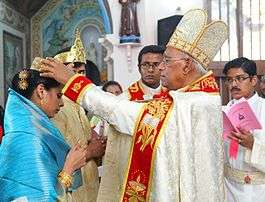
Crowning during a Nasrani wedding in the Syro-Malabar Catholic Church
-
On the beach
-
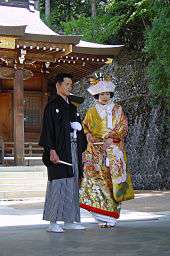
Japanese bride and bridegroom
-
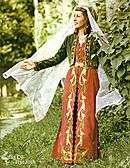
Traditional Armenian wedding dress
-
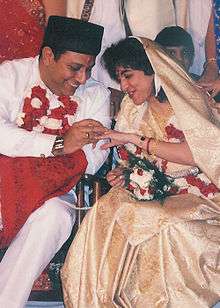
A Parsi wedding
-

Assyrian bride and groom
-
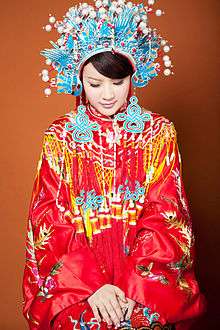
Chinese traditional wedding dress, Qing Dynasty style
-

Chinese traditional wedding clothing, Ming Dynasty style
-

Chinese traditional wedding attire, Zhou Dynasty style
-
.jpg)
Wedding at Burning Man
-

Bridegroom, Bangladesh
-

Bride, Bangladesh
-
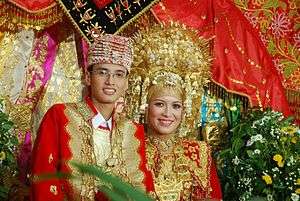
Minangkabau marriage in Indonesia
-
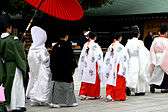
Japanese wedding at the Meiji Shrine
Wedding music
 |
|
| Problems playing this file? See media help. | |
Western weddings
Music played at Western weddings includes a processional song for walking down the aisle (ex: wedding march) either before or after the marriage service. An example of such use is reported in the wedding of Nora Robinson and Alexander Kirkman Finlay in 1878.[8] Relevant music includes:
- Various works for trumpet and organ, arguably the most famous of which include the Prince of Denmark's March by Jeremiah Clarke as a processional, the "Trumpet Tune" by Henry Purcell and the "Trumpet Voluntary" by John Stanley as recessionals.
- Selections by George Frideric Handel, perhaps most notably the "Air" from his Water Music as processional and the "Alla Hornpipe" as recessional.
- The "Bridal Chorus" from Lohengrin by Richard Wagner, often used as the processional and commonly known as "Here Comes the Bride". Richard Wagner is said to have been anti-Semitic,[9] and as a result, the Bridal Chorus is often not used at Jewish weddings.
- Johann Pachelbel's Canon in D is an alternative processional.
- The "Wedding March" from Felix Mendelssohn's incidental music for the Shakespeare play, A Midsummer Night's Dream, used as a recessional.
- The "Toccata" from Charles-Marie Widor's Symphony for Organ No. 5, used as a recessional.
- Segments of the Ode to Joy, the fourth movement of Ludwig van Beethoven's Ninth Symphony.
- Other alternative considerations include various contemporary melodies like Bob Marley's One Love which is often performed by a steel drum band.[3]
Religious aspects of weddings
Most religions recognize a lifelong union with established ceremonies and rituals. Some religions permit polygamous marriages or same-sex marriages.
Many Christian faiths emphasize the raising of children as a priority in a marriage. In Judaism, marriage is so important that remaining unmarried is deemed unnatural. Islam also recommends marriage highly; among other things, it helps in the pursuit of spiritual perfection. The Bahá'í Faith sees marriage as a foundation of the structure of society, and considers it both a physical and spiritual bond that endures into the afterlife.[10] Hinduism sees marriage as a sacred duty that entails both religious and social obligations. By contrast, Buddhism does not encourage or discourage marriage, although it does teach how one might live a happily married life and emphasizes that marital vows are not to be taken lightly.
Different religions have different beliefs as regards the breakup of marriage. For example, the Roman Catholic Church believes that marriage is a sacrament and a valid marriage between two baptized persons cannot be broken by any other means than death. This means that civil divorcés cannot remarry in a Catholic marriage while their spouse is alive. In the area of nullity, religions and the state often apply different rules. A couple, for example, may begin the process to have their marriage annulled by the Catholic Church only after they are no longer married in the eyes of the civil authority.
Customs associated with various religions and cultures
Christian customs
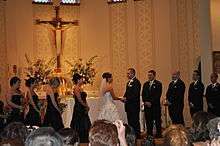
Most Christian churches give some form of blessing to a marriage; the wedding ceremony typically includes some sort of pledge by the community to support the couple's relationship. A church wedding is a ceremony presided over by a Christian priest or pastor. Ceremonies are based on reference to God, and are frequently embodied into other church ceremonies such as Mass.[11] Customs may vary widely between denominations. In the Roman Catholic Church "Holy Matrimony" is considered to be one of the seven sacraments, in this case one that the spouses bestow upon each other in front of a priest and members of the community as witnesses. As with all sacraments, it is seen as having been instituted by Jesus himself (see Gospel of Matthew 19:1-2, Catechism of the Catholic Church §1614-1615). In the Eastern Orthodox Church, it is one of the Mysteries, and is seen as an ordination and a martyrdom. The wedding ceremony of Saint Thomas Christians, an ethnoreligious group of Christians in India incorporate elements from Hindu, Jewish and Christian weddings.
A Quaker wedding ceremony in a Friends meeting is similar to any other meeting for worship, and therefore often very different from the experience expected by non-Friends.
Hindu customs

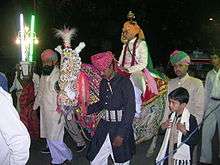
Hindu ceremonies are usually conducted totally or at least partially in Sanskrit, the language of the Hindu scriptures. The wedding celebrations may last for several days and they can be extremely diverse, depending upon the region, denomination and caste. Mehendi ceremony is a traditional ritual in Hindu weddings, where Henna application takes place on bride's hands and legs, before the wedding. On the wedding day, the bride and the bridegroom garland each other in front of the guests. Most guests witness only this short ceremony and then socialize, have food and leave. The religious part (if applicable) comes hours later, witnessed by close friends and relatives. In cases where a religious ceremony is present, a Brahmin (Hindu priest) arranges a sacred yajna (fire-sacrifice), and the sacred fire (Agni) is considered the prime witness (sākshī) of the marriage. He chants mantras from the Vedas and subsidiary texts while the couple are seated before the fire. The most important step is saptapadi or saat phere, wherein the bride and the groom, hand-in-hand, encircle the sacred fire seven times, each circle representing a matrimonial vow. Then the groom marks the bride's hair parting with vermilion (sindoor) and puts a gold necklace (mangalsutra) around her neck. Several other rituals may precede or follow these afore-mentioned rites. Then the bride formally departs from her blood-relatives to join the groom's family.
Jewish customs
A traditional Jewish wedding usually follows this format:[12][13][14][15][16]
- Before the ceremony, the couple formalize a written ketubah (marriage contract), specifying the obligations of husband to the wife and contingencies in case of divorce. The ketubah is signed by two witnesses and later read under the chuppah.
- The couple is married under a wedding canopy (chuppah), signifying their new home together. The chuppah can be made from a piece of cloth or other material attached to four poles, or a prayer shawl (tallit) held over the couple by four family members or friends.
- The couple is accompanied to the chuppah by both sets of parents, and stands under the chuppah along with other family members if desired.
- Seven blessings are recited, blessing the bride and groom and their new home.
- The couple sip from a glass of wine.
- The groom will step on the glass to crush it, usually with his right foot, ostensibly in remembrance of the destruction of the Second Temple.
- At some weddings the couple may declare that each is sanctified to the other, and/or repeat other vows, and exchange rings.
- In Orthodox and traditional Jewish weddings, the bride does not speak under the chuppah and only she receives a ring. The groom recites "Harei at mekudeshet li k'dat Moshe V'Yisrael"- "behold you are [thus] sanctified to me by the law of Moses and Israel" as he places the ring on the bride's right index finger. The bride's silence and acceptance of the ring signify her agreement to the marriage. This part of the ceremony is called kiddushin. The groom's giving an object of value to the bride is necessary for the wedding to be valid.
- In more egalitarian weddings, the bride responds verbally, often giving the groom a ring in return. A common response is "ani l'dodi, v'dodi li" (I am my beloved's, my beloved is mine)
- In some Orthodox weddings, the groom then says:
- "If I forget you, O Jerusalem, may my right hand forget its skill.
- May my tongue cling to the roof of my mouth.
- If I do not remember you,
- if I do not consider Jerusalem in my highest joy."
- The ceremony ends with the groom breaking a glass underfoot.
- The couple spend their first moments as man and wife in seclusion (apart from the wedding guests, and with no other person present). This cheder yichud - "the room of seclusion (or 'oneness')" halachically strengthens the marriage bond, since Jews are traditionally forbidden to be secluded with an unrelated person of the opposite sex.
- The ceremony is followed by a seudat mitzvah, the wedding meal, as well as music and dancing.
- At the conclusion of the wedding meal, Birkat Hamazon (Grace After Meals) is recited, as well as the seven wedding blessings.
In more observant communities, the couple will celebrate for seven more days, called the Sheva Brachot (seven blessings) during which the seven wedding blessings are recited at every large gathering during this time.
Muslim cultures
.jpg)
A wedding is typically a happy time for families to celebrate. In the Muslim world, there are colorful, cultural variations from place to place.[17]
Two male witnesses who are the members of family in most cases, are required for Nikah. According to the Quran, a married Muslim couple, both husband and wife act as each other’s protector and comforter and therefore only meant "for each other".
All Muslim marriages have to be declared publicly and are never to be undertaken in secret. For many Muslims, it is the ceremony that counts as the actual wedding alongside a confirmation of that wedding in a registry office according to fiqh, in Islam a wedding is also viewed as a legal contract particularly in Islamic jurisprudences. However, most Muslim cultures separate both the institutions of the mosque and marriage, no religious official is necessary, but very often an Imam presides and performs the ceremony, he may deliver a short sermon.[18] Celebrations may differ from country to country depending on their culture but the main ceremony is followed by a Walima (the marriage banquet).
In Islam, polygyny is allowed with certain religious restrictions, despite that an overwhelming majority of Muslims traditionally practice monogamy.
It is forbidden in Islam for parents or anyone else: to force, coerce, or trick either man or woman into a marriage that is contrary to the individual will of any one of the couple. It is also necessary for all marriages commence with the best of intentions.
Chinese cultures

At traditional Chinese weddings, the tea ceremony is the equivalent of an exchange of vows at a Western wedding ceremony. This ritual is still practiced widely among rural Chinese, however young people in larger cities, as well as in Taiwan, Hong Kong, Malaysia and Singapore, tend to practice a combination of Western style of marriage together with the Tea Ceremony.
When the bride leaves her home with the groom to his house, a "Good Luck Woman" will hold a red umbrella over her head, meaning "raise the bark, spread the leaves." This "good luck woman" should be someone who is blessed with a good marriage, healthy children and husband and living parents. Other relatives will scatter rice, red bean and green bean in front of her. The red umbrella protects the bride from evil spirit, and the rice and beans are to attract the attention of the gold chicken.
Newlyweds kneel in front of parents presenting tea. A Good Luck Woman making the tea says auspicious phrases to bless the family. Newlyweds also present tea to each other, raising the tea cups high to show respect before presenting to each other.
Those who receive the tea usually give the bride gifts such as jewelry or red envelope.
Tea Ceremony is an official ritual to introduce the newlyweds to each other's family, and it's a way for newlyweds to show respect and appreciation to their parents. The newlyweds kneel in front of their parents, serving tea to both side of parents, as well as elder close relatives. Parents give their words of blessing and gifts to the newlyweds. During tea presentation, a "Good Luck Woman" would say auspicious phrases to bless the newlyweds and the parents. These auspicious words of blessing are designed to bless and amuse the family and make the occasion filled with fun and joy.
Humanist weddings
Many traditions and rituals have origins in religions and are still performed by religious leaders. Those having a secular wedding often want to maintain the symbolic meaning of some customs since they have become an essential part of the culture independent of religion. In order to satisfy these needs, secular ceremonies have started to be carried out by humanist officiants worldwide. Since the early 1980s, the Humanist Society Scotland (HSS) has been carrying out secular ceremonies in the country. In 1987, the BBC Scotland TV series “High Spirits” for the first time aired a humanist wedding on national TV. The demand for humanist wedding has been growing since then and in 2005 HSS won a legal battle and their ceremonies are now authorized by the Registrar General of Scotland.[19]
Humanist wedding ceremonies are carried out in a variety of countries like the U.S., Canada and recently Brazil, having legal status in only a few of these countries. Humanist celebrants are able to perform valid civil marriages and civil partnerships in the Republic of Ireland.
Wedding types
Civil wedding

A civil wedding is a ceremony presided over by a local civil authority, such as an elected or appointed judge, Justice of the Peace or the mayor of a locality. Civil wedding ceremonies may use references to God or a deity (except in UK law where readings and music are also restricted),[20] but generally no references to a particular religion or denomination. They can be either elaborate or simple. Many civil wedding ceremonies take place in local town or city halls or courthouses in judges' chambers.[21]
Destination wedding
Not to be confused with an elopement, a destination wedding is one in which a wedding is hosted, often in a vacation-like setting, at a location to which most of the invited guests must travel and often stay for several days. This could be a beach ceremony in the tropics, a lavish event in a metropolitan resort, or a simple ceremony at the home of a geographically distant friend or relative. During the recession of 2009, destination weddings continued to see growth compared to traditional weddings, as the typically smaller size results in lower costs.[22]
Weddings held a prestigious venues such as castles or stately homes have become increasingly popular in the 21st century particularly in European countries such as the UK, France and Germany. From 2010 onwards, there is an increase in destination weddings that are hosted in exotic places like Indonesia, Maldives and India.
Double wedding
A double wedding is a double ceremony where two affianced couples rendezvous for two simultaneous or consecutive weddings. Typically, a fiancé with a sibling who is also engaged, or four close friends in which both couples within the friendship are engaged might plan a double wedding where both couples legally marry.
Elopement
Elopement is the act of getting married, often unexpectedly, without inviting guests to the wedding. In some cases, a small group of family and/or friends may be present, while in others, the engaged couple may marry without the consent and/or knowledge of parents or others. While the couple may or may not be widely known to be engaged prior to the elopement, the wedding itself is generally a surprise to those who are later informed of its occurrence.
Handfasting
A handfasting is an old Pagan custom, dating back to the time of the ancient Celts. A handfasting was originally more like an engagement period, where two people would declare a binding union between themselves for a year and a day. The original handfasting was a trial marriage.[23]
Highland or Scottish wedding

A Highland or Scottish wedding has the groom, with some or all of the groom's men wear a kilt. The bride may wear a sash or other tartan clothing. The Scottish basket sword is used for any Saber Arch.
Mass wedding
A collective or mass wedding is a single ceremony where numerous couples are married simultaneously.
Military wedding
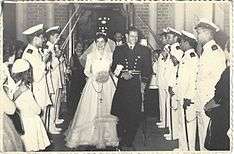
A military wedding is a ceremony conducted in a military chapel and may involve a Saber Arch. In most military weddings the bride, groom or both will wear a military dress uniform in lieu of civilian formal wear. Some retired military personnel who marry after their service has ended may opt for a military wedding.
Vow renewal wedding
A wedding vow renewal is a ceremony in which a married couple renews or reaffirms their wedding vows. Typically, this ceremony is held to commemorate a milestone wedding anniversary. It may also be held to recreate the marriage ceremony in the presence of family and friends, especially in the case of an earlier elopement.
Same-sex wedding
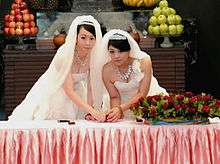
A same-sex wedding is a ceremony in which two people of the same sex are married. This event may be legally documented as a marriage or another legally recognized partnership such as a civil union. Where such partnerships are not legally recognized, the wedding may be a religious or symbolic ceremony designed to provide an opportunity to make the same public declarations and celebration with friends and family that any other type of wedding may afford. These are often referred to as commitment ceremonies. Same-sex weddings are not legally recognized in most countries. The first laws enabling same-sex marriage in modern times were enacted during the first decade of the 21st century. As of 1 January 2016, nineteen countries of 206 total states (Argentina, Belgium, Brazil, Canada, Denmark,[nb 1] France, Iceland, Ireland, Luxembourg, the Netherlands,[nb 2] New Zealand,[nb 3] Norway, Portugal, South Africa, Spain, Sweden, the United Kingdom,[nb 4] the United States and Uruguay) and certain sub-national jurisdictions (parts of Mexico) allow same-sex couples to marry. Polls show rising support for legally recognizing same-sex marriage in the Americas and in parts of Europe.[24]
Officiants at same-sex weddings may be religiously ordained. Some religions and branches of religions, including Quakers, Lutherans, Reformed, Unitarians, Ethical Culture, Reform Jews and Reconstructionist Jews, the Metropolitan Community Church, the Reformed Catholic Church, and Buddhist organizations like Soka Gakkai perform and recognize same-sex marriages, even if the governments of the states where they live may not.
Wedding ceremonies for gay couples are internally very diverse, with some patterned closely after traditional opposite-sex weddings and others created ex nihilo.
Shotgun wedding
A shotgun wedding is a wedding in which the groom is reluctant to marry the bride, however, is strongly encouraged to do so to avoid family, social or legal repercussions. In many cases, the bride is pregnant before the wedding and the family of the bride, most commonly the bride's father, insists that the groom marry the bride before the pregnancy becomes obvious.
Weekend wedding
A weekend wedding is a wedding in which couples and their guests celebrate over the course of an entire weekend. Special activities, such as spa treatments and golf tournaments may be scheduled into the wedding itinerary. Lodging usually is at the same facility as the wedding and couples often host a Sunday brunch for the weekend's finale.
White wedding
_(3527495977).jpg)
A white wedding is a term for a traditional formal or semi-formal Western wedding. This term refers to the color of the wedding dress, which became popular after Queen Victoria wore a pure white gown when she married Prince Albert and many were quick to copy her choice. At the time, the color white symbolized both extravagance and sexual purity to many and had become the color for use by girls of the royal court.[1]
Peasant wedding
A peasant wedding is a Dutch carnaval custom. Not everywhere in Limburg and Brabant is a boerenbruiloft (peasant's wedding) part of the carnaval. Especially in the northern and central part of Limburg and eastern part of North Brabant is the boerenbruiloft very often held during the carnaval and is an important part of the carnaval culture. Each carnaval association has its own tradition concerning choosing the spouse for a wedding. Often the bride and groom are chosen by the council of eleven or by the couple that was married the year before.
It is not necessary that the newlyweds are a couple in real life. It is also not necessary that the bride and groom are single. Both the bride and groom, however, should be in love during the carnaval and they need to transfer their love to all the people who celebrate their wedding along with them. The highlight of the festival of the peasant wedding is the wedding and feast of the onecht (not-marriage) of the bride and groom. There are many aspects that can be found in a real-life marriage. First the engagement will be announced just as if it would be an officially marriage. And both the families should learn to know each other very well in organizing the party and the ceremony, like a normal wedding. The two families prepare a piece of entertainment for the wedding.[25] And just like a real wedding, a reception and a feast is organized where guests are asked to wear appropriate clothing. The bride and groom will often dress in wedding clothing from before 1940. The bride for example will often wear a poffer, which is a traditional Brabantian headdress.[26]
Origin
The first mention of a "boerenbruiloft" (peasant wedding) was in 1582, when the Saxon elector August in Dresden wedded a peasant and his wife during a large ritual ceremony d'n onech (the not-marriage). It was not a real wedding and the to-be spouse were also not real peasants, but rather the nobility. The real peasants were given the role of noblemen. It was a reversal ritual, in which the roles were deliberately reversed. This role reversal was intended to avoid the attraction of the christian God. Within the noble circles it was believed that it was the eye of the god which at the beginning of the spring focused on them because of their failure in the past year. They thought they could escape this danger by dressing during this wedding celebrations and to behave as peasants, and thus appear to be the people at the bottom of the social ladder. They believed the consequence was that the peasants dressed as nobleman would be harmed by their god instead of the nobles themselves.[26]
Wedding ceremony participants
.jpg)
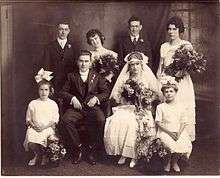
Wedding ceremony participants, also referred to as the wedding party, are the people that participate directly in the wedding ceremony itself.
Depending on the location, religion, and style of the wedding, this group may include only the individual people that are marrying, or it may include one or more brides, grooms (or bridegrooms), persons of honor, bridespersons, best persons, groomsmen, flower girls, pages and ringbearers.
A woman’s wedding party consists of only those on her side of the wedding party. Those on a groom’s side are called his groom’s party.
- Bride: A woman/women about to be married.
- Bridegroom or Groom: A man/men about to be married.
- Marriage officiant: the person who officiates at the wedding, validating the wedding from a legal and/or religious standpoint. This person may be a judge, justice of the peace, or a member of clergy. In Hindu marriages, the marriage officiant is called a pandit or Brahmin.[27]
- Best Man, Woman, or Person: The chief assistant to a bridegroom at a wedding, typically a sibling or friend of special significance in his life. Often holds the wedding rings until their exchange.
- Mother of the Bride or Groom: The mother of either the bride or groom.
- Maid, Matron or Man of Honor: The title and position held by a bride's chief attendant, typically her closest friend or sibling.
- Bridesmaids: The female attendants to a bride. Males in this role may be called honor attendants or sometimes bridesmen, but that term has a different traditional meaning.
- Groomsmen or Ushers: The attendants, usually male, to a bridegroom in a wedding ceremony. Female attendants, such as a sister of the groom, are typically called honor attendants.
- Page(s): Young attendants may carry the bride’s train. In a formal wedding, the ring bearer is a special page who carries the rings down the aisle. The coin bearer is similar page who marches on the wedding aisle to bring the wedding coins.
- Flower girl(s): In some traditions, one or more children carry bouquets or drop rose petals in front of the bride in the wedding procession.
Wedding Industry
The global wedding industry was worth $300 billion as of 2016. The United States wedding industry alone was estimated to be worth $60 billion as of the same year. In the United States, the wedding industry employs over one million people throughout 600,000 businesses, and grows 2% each year. The industry has undergone a transition due to the increased use of technology. Bridal websites, blogs, and social media accounts have driven spending up and created new trends and traditions.[28]
See also
| Relationships |
|---|
|
Activities |
|
Endings |
- Wedding anniversary
- Wedding photography
- Wedding videography
- Marryoke
- Wedding invitation
- Wedding planner
- Green wedding (a.k.a. eco-friendly wedding)
Notes
- ↑ Excluding the Faroe Islands and Greenland.
- ↑ Excluding Aruba, Curaçao and St Maarten.
- ↑ Excluding Tokelau, Niue and the Cook Islands.
- ↑ Excluding Northern Ireland and territories outside the four constituent countries, such as the Crown dependencies.
References
- 1 2 Otnes, Cele & Pleck, Elizabeth (2003). Cinderella Dreams: the Allure of the Lavish Wedding, p. 31. University of California Press, Berkeley.
- ↑ Howard, Vicky (2006). Brides Inc.: American Weddings and the Business of Tradition, p. 34. University of Pennsylvania Press, Philadelphia.
- 1 2 Howard, Vicky (2006). Brides Inc.: American Weddings and the Business of Tradition, p. 61. University of Pennsylvania Press, Philadelphia.
- ↑ Archived August 14, 2012, at the Wayback Machine.
- ↑ "Kilts: tightly woven into Scots culture". Scotsman. 2005-02-10. Archived from the original on 2007-02-02. Retrieved 2007-04-16.
- ↑ "The Scottish Kilt". Visit Scotland. Retrieved 2007-04-16.
- ↑ Jim Murdoch. "Scottish Culture and Heritage: The Kilt". Scotsmart. Retrieved 2007-04-16.
- ↑ "Marriage of Mr A.K. Finlay and Miss Robinson". The Queanbeyan Age. NSW. 14 August 1878. p. 1. Retrieved 4 September 2013.
- ↑ Cooke, Deryck V. "Richard Wagner | German composer". Britannica.com. Retrieved 2015-11-10.
- ↑ Smith, Peter (2000). "Marriage". A concise encyclopedia of the Bahá'í Faith. Oxford: Oneworld Publications. pp. 232–233. ISBN 1-85168-184-1.
- ↑ "Wedding arrangements". Web.archive.org. 2008-06-23. Archived from the original on December 16, 2008. Retrieved 2015-11-10.
- ↑ "Guide to the Jewish Wedding". Retrieved 2008-07-03.
- ↑ "Nissuin: The Second of the Two Ceremonies". Retrieved 2008-07-03.
- ↑ "Understanding the Jewish Wedding". Archived from the original on 2007-09-21. Retrieved 2008-07-03.
- ↑ "Ceremony: Jewish Wedding Rituals". Retrieved 2008-07-03.
- ↑ "Marriage in Jewish Art". Retrieved 2008-07-03.
- ↑ Dodge, Christine Huda. "Islamic Wedding Party Customs". About.com. Retrieved 8 June 2013.
- ↑ "Religions - Islam: Weddings". BBC. Retrieved 2015-11-10.
- ↑ "Humanist Society Scotland | Celebrate the one life we have". Humanism-scotland.org.uk. 2015-08-28. Retrieved 2015-11-10.
- ↑ "England and Wales", Music Not Allowed at Civil Ceremonies (article), Wedding Music Designer (Simon Jordan)
- ↑ Gavira, Juan. "Characteristics of a spanish wedding". Juangavira.com
- ↑ Parsons, Claudia (2009-05-12). "Destination weddings see growth despite recession". Reuters. Retrieved 2015-11-10.
- ↑ "About Handfastings". Handfastings.org. Retrieved 2015-11-10.
- ↑ See
- Newport, Frank. "For First Time, Majority of Americans Favor Legal Gay Marriage". Gallup. Retrieved 25 September 2012.
- ↑ "Wedding Day Invitation Styles and Designs – A Vintage Approach". Houseplantation. Retrieved 2016-08-26.
- 1 2 "Boerenbruiloft: hoezo in het 'onecht' verbonden? | Vastelaovend en Carnaval in Limburg". Vastelaovendinlimburg.nl. 2013-04-08. Retrieved 2013-10-29.
- ↑ A person who do all the rituals at Temples and also act as a Marriage officiant in Hindu culture.
- ↑ http://www.huffingtonpost.com/matt-douglas/part-1-the-past-present-f_b_9294420.html
External links
| Wikimedia Commons has media related to Wedding ceremonies. |
| Wikivoyage has a travel guide for Wedding travel. |
 The dictionary definition of wedding at Wiktionary
The dictionary definition of wedding at Wiktionary
.jpg)
